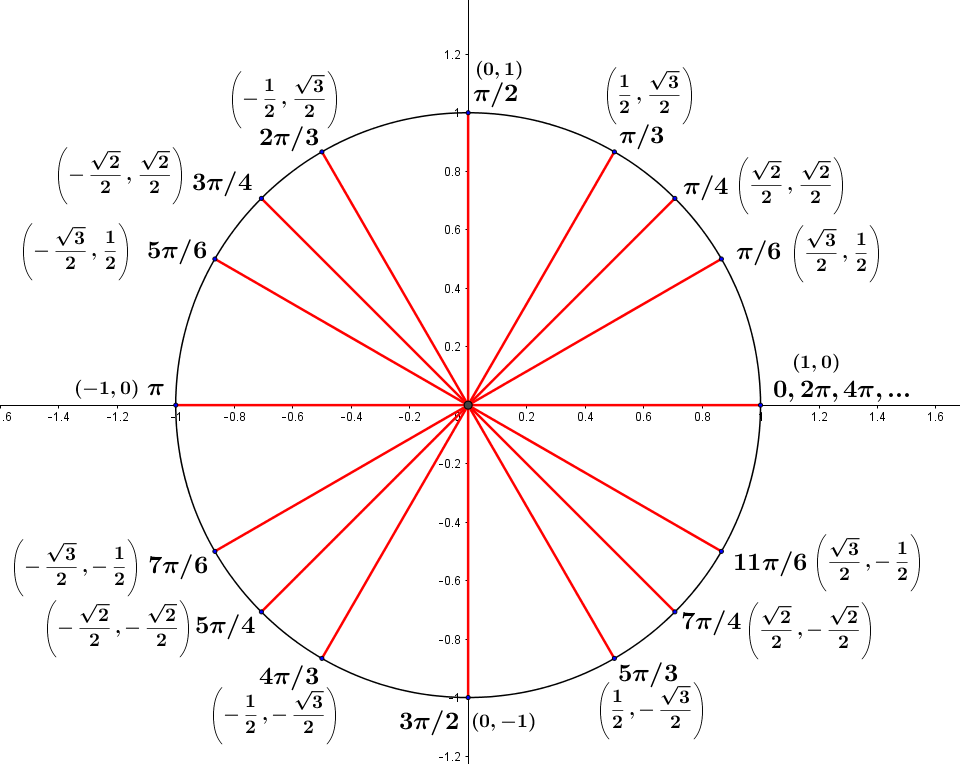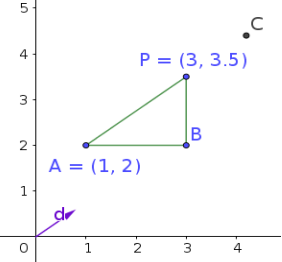Common Unit Circle Angles

Figure 1 depicts a unit circle with multiple lines emanating from its center. Each line forms an angle with the $x$ axis as measured counter clockwise from the right side horizontal ($x$-axis). So for example, the first line up has the angle $\pi/6$ and the second one has angle $\pi/4$ and so forth around the circle. In addition to labeling the angles, the graphic labels the $xy$ coordinate values for the intersection of the line with the unit circle. These values are, of course, $(\cos\theta,\;\sin\theta)$.
Although none are shown, we could also imagine a negative angle, such as $-\pi/6$. That angle would be obtained by traversing the circle clock wise from the $x$-axis. Alternatively, the negative angle could be made positive by subtracting it from $2\pi$. All angles, no matter how large or small, are on the circle. If the angle were given as $107\pi/8$, and we want to know where it would graph on the circle, we just need to subtract out intervals of $2\pi$ until it is between $0$ and $2\pi$. This is most conveniently done with modular division. $$mod\left(\frac{107\pi}{8},\;\frac{16\pi}{8}\right)=\frac{11\pi}{8}$$ Negative angles arise naturally in multiple situations. It is worth noting that $$sin(-\theta)=-sin(\theta) \Longleftarrow \text{odd function}$$ $$cos(-\theta)=cos(\theta) \Longleftarrow \text{even function}$$
Definition: Even Function. A function, that when graphed in the plane, is symmetric (mirrored) about the vertical, $y$, axis. A function that when $x$ is replaced by $-x$ continues to yield the same value. $f(-x)=f(x)$ Most functions are neither odd nor even.
Definition Odd Function. A function, that when graphed in the plane, is anti-symmetric about the vertical, $y$, axis. A function that when $x$ is replaced by $-x$ yields the negative of the original function. $f(-x)=-f(x)$. Most functions are neither odd nor even.
Given a negative angle, we can use the even odd properties of the sine and cosine to obtain equivalent numeric information for a positive angle. For example, if $\theta=-2\pi/3$, then its cosine and sine must also be $[cos(2\pi/3),\;-sin(2\pi/3)]$.
Knowing if a function is even or odd can make a definite integral a little easier. "Even" functions are mirrored across the $y$ axis and thus their integral to the right of the $y$-axis is equal to their integral to the left of the axis.
Unit Vectors "Lite"
Every point on the unit circle defines a unit vector. A unit vector is a vector with length $1$ and all points on the unit circle have length $1$. If a unit vector is multiplied by a length, $r$, then the new point is in the direction of the unit vector but at the distance $r$, from origin. This is really handy as it allow us to place a point in a vector direction that is some known distance from the origin.
Answer: First the unit direction vector will be $\mathbf{u}=\left(\begin{array}{c} \cos(12^{\circ})\\ \sin(12^{\circ}) \end{array}\right),$ which we have to express in radians (or else just use the degree mode on a calculator) and we find that $\mathbf{u}=\left(\begin{array}{c} 0.9781\\ 0.2079 \end{array}\right).$ So $P=3\cdot\left(\begin{array}{c} 0.9781\\ 0.2079 \end{array}\right)=\left(\begin{array}{c} 2.9344\\ 0.6237 \end{array}\right).$ We can check this with our distance formula: $$\sqrt{2.9344^{2}+0.6237^{2}}=3.$$ If we have a point, $P$, somewhere in the plane, and we want to know the direction to it as a “unit vector”, then $$\mathbf{u}=\frac{P}{|P|}.$$ And of course, $|P|=\sqrt{P_{x}^{2}+P_{y}^{2}}=\text{length of P}.$
